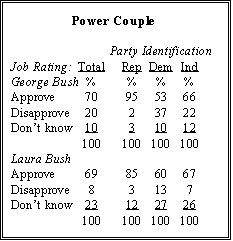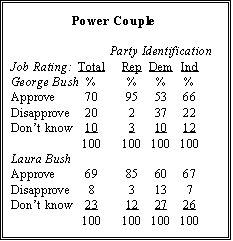Research Findings
 Americans like Laura Bush even more than they did a year ago, and her public image is better defined these days. Seven-in-ten (69%) say they approve of the way Mrs. Bush is handling her job, up from 58% last July. A year ago, fully a third of the public (34%) had not formed an opinion of the First Lady’s job performance; that number has declined to 23%. And Mrs. Bush’s negative rating just 8%, unchanged from last year remains much lower than those of other recent first ladies.
Americans like Laura Bush even more than they did a year ago, and her public image is better defined these days. Seven-in-ten (69%) say they approve of the way Mrs. Bush is handling her job, up from 58% last July. A year ago, fully a third of the public (34%) had not formed an opinion of the First Lady’s job performance; that number has declined to 23%. And Mrs. Bush’s negative rating just 8%, unchanged from last year remains much lower than those of other recent first ladies.
The terms people use to describe Mrs Bush reflect changing public perceptions of her. Asked for one-word descriptions of the First Lady, the responses are almost uniformly positive, as they were last year. Once again, “nice” leads the list, but terms like “honest,” “confident” and “sincere,” are mentioned much more often than a year ago. Fewer people describe her as “elegant” or emphasize her role as a mother (for list, see pg. 4).
Mrs. Bush draws support from across the political spectrum, even when compared with the president, who has relatively strong approval ratings among the opposing party. By more than four-to-one (60%-13%) Democrats approve of her job performance; President Bush’s ratings among Democrats are positive but more mixed (53%-37%). Republican ratings for the president and First Lady are overwhelmingly positive.
 Age and gender are associated with impressions of the First Lady. Women below the age of 50, in particular, emphasize Laura Bush’s confidence and intelligence; men in that age group most often cite her honesty or describe her as “classy.” Older men view Mrs. Bush as “nice” and “classy,” while women age 50 and older most frequently describe her as “ladylike.”
Age and gender are associated with impressions of the First Lady. Women below the age of 50, in particular, emphasize Laura Bush’s confidence and intelligence; men in that age group most often cite her honesty or describe her as “classy.” Older men view Mrs. Bush as “nice” and “classy,” while women age 50 and older most frequently describe her as “ladylike.”
There is no consensus as to who represents the ideal First Lady despite Mrs. Bush’s current popularity. Asked to name which recent First Lady comes closest to that idea, 30% mention Sen. Hillary Clinton, while almost as many (26%) cite Barbara Bush, Laura Bush’s mother-in-law. Roughly one-in-five (19%) name Laura Bush and the same number mention Nancy Reagan. A year ago, when Mrs. Bush was new on the job, just 6% pointed to her as fitting the idea of a First Lady.
Partisanship is a factor here. Among the last four First Ladies (including Laura Bush), Sen. Clinton has the advantage of being the only Democrat. While half of Democrats (51%) name Clinton as coming closest to the idea of what a First Lady should be, Republicans are split between Barbara Bush (35%), Laura Bush (29%) and Nancy Reagan (27%).
Conservative Republicans are most likely to view Laura Bush as coming closest to the idea of a First Lady: as many conservative Republicans name her (34%) as cite Barbara Bush (33%). However, for moderate and liberal Republicans Barbara Bush (38%) is the top choice. Nearly twice as many of these more centrist Republicans name Barbara Bush as cite Laura Bush (20%).
 Sen. Clinton is overwhelmingly popular among liberal Democrats, but just 46% of moderate and conservative Democrats see her as the ideal First Lady. On balance as many of the latter group named one of the Republican First Ladies as chose Hillary Clinton.
Sen. Clinton is overwhelmingly popular among liberal Democrats, but just 46% of moderate and conservative Democrats see her as the ideal First Lady. On balance as many of the latter group named one of the Republican First Ladies as chose Hillary Clinton.
There also is a generation gap when it comes to First Ladies. For those under age 50, Hillary Clinton is seen as coming closest to the ideal First Lady (33%). For those over 50, Barbara Bush is seen as coming closest to that ideal (31%). Laura Bush fares about the same in both groups (17% under 50, 22% 50 and over). But Republicans age 50 and over are slightly more likely to name Mrs. Bush than their younger counterparts (35% vs. 26%).


